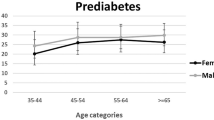Abstract
This study was designed to evaluate the epidemiology of type 2 diabetes and hypertension in Uygur and Kazak ethnic populations. A three-step stratified sampling method was used. Questionnaires, blood pressure, anthropometric measurement, and fasting blood glucose were monitored. In total, 1,571 Uygur and 2,913 Kazak subjects were randomly enrolled. The prevalence of type 2 diabetes and glucose intolerance was 5.55- and 1.90-fold higher, respectively, in Uygur than in the Kazak population (8.16 vs. 1.47%, P < 0.001 and 3.29 vs. 1.73%, P < 0.001). However, the prevalence of hypertension and obesity was significantly higher in the Kazak than in the Uygur population (hypertension: 43.52 vs. 31.98%, P < 0.001; obesity: 25.0 vs. 14.5%, P < 0.001, respectively). Our data suggest a significantly different prevalence in hypertension, hyperlipidemia, and type 2 diabetes between the two ethnic groups. The prevalence of type 2 diabetes was much lower, while the prevalence of hypertension was much higher associated with a higher incidence of obesity in the Kazak population. Individuals with a greater BMI and blood pressure were more prone to development of type 2 diabetes. Our data revealed that waist circumference of Kazak ethnics was greater than that of Uygur, even at the same BMI level. Serum fasting glucose was associated with different factors in Uygur and Kazak.

Similar content being viewed by others
References
World Health Organization. (1999). Definition, diagnosis and classification of diabetes mellitus and its complications: Report of a WHO consultation. Part 1: Diagnosis and classification of diabetes mellitus. Geneva, WHO (WHO/NCD/NCS/99.2).
Yan, W., Yang, X., Zheng, Y., Ge, D., Zhang, Y., Shan, Z., et al. (2005). The metabolic syndrome in Uygur and Kazak populations. Diabetes Care, 28, 2554–2555. doi:10.2337/diacare.28.10.2554.
Gu, D., Reynolds, K., Wu, X., Chen, J., Duan, X., Reynolds, R. F., et al., Inter-ASIA Collaborative Group. (2005). Prevalence of the metabolic syndrome and overweight among adults in China. Lancet, 365, 1398–1405. doi:10.1016/S0140-6736(05)66375-1.
International Diabetes Federation. The IDF consensus worldwide definition of the metabolic syndrome. http://www.metabolicsyndromeinstitute.com/medicalinformation/literaturereview/2005/document.2005-05-19.5770709184.
James, W. P. (2008). The epidemiology of obesity: The size of the problem. Journal of Internal Medicine, 263, 336–352. doi:10.1111/j.1365-2796.2008.01922.x.
Gu, D., Reynolds, K., Duan, X., Xin, X., Chen, J., Wu, X., et al., Inter ASIA Collaborative Group. (2003). Prevalence of diabetes and impaired fasting glucose in the Chinese adult population: International Collaborative Study of Cardiovascular Disease in Asia (InterASIA). Diabetologia, 46, 1190–1198. doi:10.1007/s00125-003-1167-8.
Wu, H. Y., Chen, L. L., Zheng, J., Liao, Y. F., & Zhou, M. (2007). Simple anthropometric indices in relation to cardiovascular risk factors in Chinese type 2 diabetic patients. The Chinese Journal of Physiology, 3, 135–142.
Li, L. L., Zhang, Y. M., Du, J. Y., Mao, X. M., Wu, X. H., Ran, X. J., et al. (2005). Analysis of metabolic features and food composition related with pathogenesis of type 2 diabetes mellitus in population of Uigurs and Kazaks in Xinjiang. Chinese Journal of Endocrinology and Metabolism, 21, 141–142.
Huxley, R., & James, W. P. (2008). Ethnic comparisons of the cross-sectional relationships between measures of body size with diabetes and hypertension. Obesity Reviews, 1, 53–61. doi:10.1111/j.1467-789X.2007.00439.x.
Feng, Y., Zang, T., Xu, X., & Xu, X. (2008). Familial aggregation of metabolic syndrome and its components in a large Chinese population. Obesity, 1, 125–129.
Tseng, C. H. (2007). Body mass index and blood pressure in adult type 2 diabetic patients in Taiwan. Circulation Journal, 11, 1749–1754.
Acknowledgments
The study was supported by the Technology Government Agency of Xinjiang Uygur Autonomous Region. This study was supported in part by the Inter-centennial Outstanding Talent Scholarship from the Ministry of Education, People’s Republic of China (2005–2008, NCET-04-0992), the National Natural Science Foundation of China (30660211, 30660288) and Xinjiang Uygur autonomic Tackle Key Problems Plans (2006–2008, 200633129). The work also received support from Diabetes Vip lab of First affiliated Hospital of Xinjiang Medical University. The authors wish to thank all participants of this study.
Author information
Authors and Affiliations
Corresponding author
Rights and permissions
About this article
Cite this article
Tao, Y., Mao, X., Xie, Z. et al. The Prevalence of Type 2 Diabetes and Hypertension in Uygur and Kazak Populations. Cardiovasc Toxicol 8, 155–159 (2008). https://doi.org/10.1007/s12012-008-9024-0
Received:
Accepted:
Published:
Issue Date:
DOI: https://doi.org/10.1007/s12012-008-9024-0




